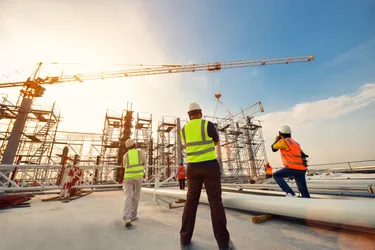
Following the Prime Minister’s announcement on Sunday 10 May, the government is now actively encouraging construction to return to work provided it can be achieved safely and in accordance with the latest Covid-secure standards.
On Monday 11 May the Department for Business, Energy & Industrial Strategy (BEIS), in consultation with Public Health England (PHE) and the Health and Safety executive (HSE), with input from industry bodies, unions and businesses published their “Working safely during coronavirus (COVID-19) in construction and other outdoor work” document, which aims to provide guidance to those working in construction and outdoor environments.
You can download the full PDF version of the guidance here.
As a responsible designer, manufacturer and supplier of construction products into the UK, Axter will be issuing our own waterproofing and flat roofing system specific guidance, to assist our customers and colleagues in staying safe from coronavirus (Covid-19) whilst working on flat roofs and in the construction sector.
Prior to this, we have reviewed this latest government guidance and highlight some key points of interest:
Managing risks. Make sure people understand what they need to do to maintain safety on construction sites during coronavirus (COVID-19).
Social distancing. Maintain 2m distancing wherever possible including while arriving at and departing from site, while on site and when travelling between sites. Stagger arrival and departure times. Restrict access to areas and separate sites into working zones to keep workers physically separated. Hold site inductions outdoors wherever possible, reduce the number of attendees and maintain social distancing.
Site hygiene. Maintain hygiene standards, encourage increased hand washing and ensure hand sanitisers are provided in multiple locations as well as washrooms. Keep the site, site equipment and regular site touch points clean and sanitise all equipment after use.
Personal protective Equipment (PPE). Where you are already using PPE in your construction activity to protect against non-COVID-19 risks, you should continue to do so. Additional PPE beyond what you usually wear on site is not beneficial. Construction sites should not encourage the precautionary use of extra PPE to protect against COVID-19 outside clinical settings.
Face coverings. Wearing a face covering does not protect you, but it may protect others if you are infected but have not developed symptoms. Wearing a face covering may be marginally beneficial as a precautionary measure where social distancing isn’t possible. They are very simple, just need to cover your nose and mouth and are not the same as a face mask used by health and care workers or construction activity specific PPE used to manage risks like dust hazards. You can make face coverings at home and can find guidance on how to do this and use them safely on GOV.UK.
Work related travel. Avoid unnecessary work travel. Avoid public transport where possible in favour of walking, cycling or running or travel alone using your own vehicle. Minimise the number of people travelling together, use fixed travel partners, increase ventilation in vehicles and avoid sitting face-to-face. If staying away for work, ensure accommodation meets social distancing guidelines.
Site deliveries. Maintain 2m social distancing, minimise contact through use of non-contact delivery receipt and approval methods. Encourage drivers to stay in their vehicle when practical to do so.
15th May 2020
